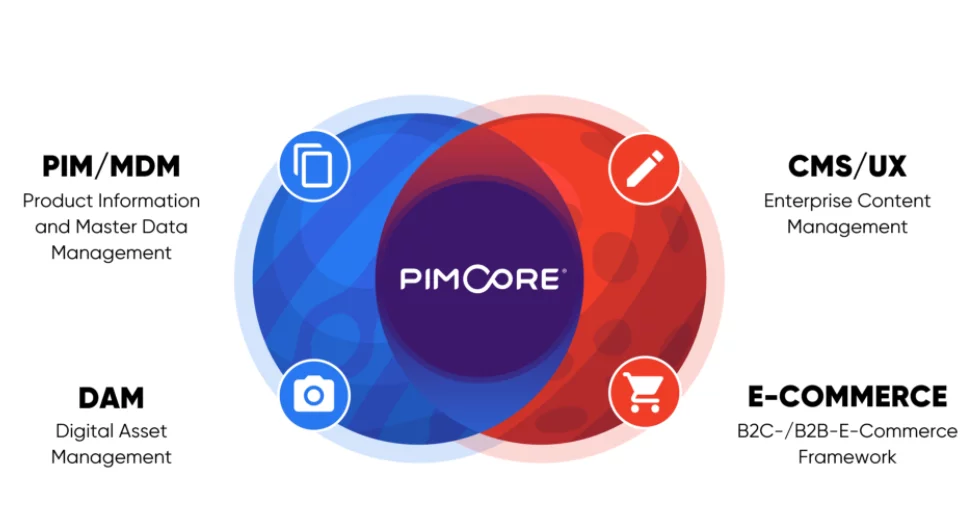Revolutionary architecture in the Digital Marketing market - Digital Experience Platform (DXP) vs traditional CMS
Free consultationTopics
- DIgital Experience Platform
- DXP
- Content Management System
- Pimcore
A major challenge for companies offering complex products is to present them to their audiences in a clear and understandable manner. In such a situation, an important step in acquiring customers is to educate them and provide them with all the information they need regarding the products offered. How to do it efficiently and effectively lead them to purchase? Tools to facilitate the aforementioned goal are provided by Digital Experience Platforms (DXP), which help automate marketing by shaping and optimizing the customer experience across all communication channels.
What is DXP (Digital Experience Platform)
DXP is a platform that acts primarily as a central system for collecting data on user behavior, analyzing it, creating tailored content and, based on that, delivering that content to users in whatever channel they encounter the organization and information about its offerings. As a result, this allows for effective improvement of the customer experience, which is the primary goal and objective of DXP solutions.
Going into more technical details, DXP platforms should be understood as organizationally central collections of content, from which they are delivered via dedicated APIs to various channels and applications (e.g. landing pages, mobile apps, mailings, social media, e-commerce, web portals).
DXP addresses the natural evolution of technology, which is becoming increasingly agile to deal with more complex tasks. The platform is also inspired by the growing need for a fully connected environment, where every customer interaction with any touchpoint is passed on to optimize the next interaction. Customer Experience (CX) has now evolved into full-fledged relationship management, and DXP can help manage every step of the customer journey in learning about, buying and subsequently using your product or service.

The obligation of "all-encompassing experience" and integration with neighboring technologies are driving its further expansion. Therefore, it is safe to say that such platforms will soon become the technological "center of the digital customer experience," affecting the entire organization. This, in turn, makes it possible to introduce marketing automation at a very high level.
In other words, the DXM platform connects:
- User Experience (Customer Experience), the total experience of buying goods or using the services of an enterprise. These include the website, e-commerce, apps, emails, BOK.
- Marketing processes, i.e. purchasing, claims, self-service, onboarding, registration.
- Central content registries, namely Content Management System (CMS), Product Information System (PIM), Digital Asset Management (DAM).
.webp)
Digital Experience Platform vs Content Management System
DXP is a step up from CMS (Content Management System) when it comes to helping brands analyze, implement and create digital customer experiences when interacting with the brand and its products via websites, apps, portals, IoT devices and more. DXP guarantees an integrated and rationalized structure that provides an organization with analytical tools and software functions to generate tailored customer experiences. As a result, DXP can be seen as an ideal solution for companies to digitize operations and gather useful customer information.
The CMS provides collaboration, allowing users to manage documents and output for editing with multiple authors and publishing to websites. It uses a content repository or database to store page content, metadata and other information resources. DXP goes beyond that - it connects the entire data architecture and all platforms involved in the value-added cycle of the offering.

DXP is gaining popularity, and many vendors are delivering CMS with DXP to ensure the best possible outreach with tailored communications that match the expectations, interest and knowledge level of the end user. Although CMS continues to be at the center of technology to support User Experience initiatives, companies prefer the integrated architectures needed to serve large enterprises at the speed of ever-changing customer expectations.
Pimcore DXP
One of the systems offering support for user experience management is Pimcore DXP, which is the only one to provide, in the form of a free open-source license, such advanced functions for collecting data on user behavior, allows to conduct advanced analysis, create digital experience strategies, and manage data and user experience. Those using this powerful tool, which is Pimcore DXP, have access to completely new possibilities for creating communications of the offer to target groups.

How to use DXP? What is dynamic content generation (Dynamic Content Generation)
An excellent example of the application of Pimcore DXP's capabilities can be the dynamic modification of the content of sub-pages of an online store based on data about the user who is just making his visit to the store. Based on data about the customer's previous purchases, how he or she uses the site, what subsites he or she visits, what products he or she is looking for, and based on data from other systems such as CRM, we can automatically modify on the fly the content that shows up for that particular customer.
Thus, people looking at, for example, blue women's T-shirts in the store can be automatically, on the basis of defined rules, classified into appropriate customer segments, for which the content manager has prepared special content, such as a banner on the homepage, products in promotion, suggested articles on the block and in the guide, or a completely different architecture of the entire entrance page and menu of the online store. Thus, over time, the store, collecting data on user behavior, adapts to the user's preferences, and its design and content sets presented to the visitor are unique and tailored to the visitor's preferences and expectations.
.webp)
This process is called Dynamic Content Generation and is performed using Pimcore's built-in, free "out-of-the-box" features. Of course, it is up to the content manager [content manager] or customer experience manager [CX manager] to determine the strategy for creating dynamic content, no less the mechanisms for its optimized presentation work effectively and fully automatically thanks to the capabilities of Pimcore DXP.